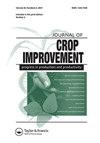尼日利亚伊巴丹木薯淀粉产量的基因型变异
IF 1.5
Q3 AGRONOMY
引用次数: 0
摘要
淀粉是主要主食作物的重要营养成分,木薯是已知作物中单位面积淀粉产量最高的。木薯育种应注重干(可利用)根产量,这决定了最终产品的产量。对尼日利亚伊巴丹6个木薯基因型(COB-4-75、COB-4-100、COB-5-4、COB-5-53、COB-6-4和COB-7-25)和2个检测型(TMS30572和TMEB419)在2个季节的干淀粉产量(DSY)进行了评价。试验采用随机完全区组设计,2个重复。种植12个月后收获植株,收集鲜根重和总生物量数据。利用田间数据估算了收获指数(HI)和鲜储根产量(FSRY)。测定每个基因型的淀粉含量,并与FSRY一起用于估计淀粉产量。数据进行方差分析和相关分析。FSRY、HI和DSY基因型之间存在显著差异。COB-4-100的平均FSRY和DSY最高,分别为30.72和4.29 t/ha,而COB-5-53的平均FSRY和DSY最低,分别为13.19和1.71 t/ha。COB-7-25的HI最高(0.57),COB-5-53的HI最低(0.28)。DSY与HI (r = 0.65)和FSRY (r = 0.91)的相关系数显著,FSRY与HI的相关系数也显著(r = 0.66)。COB-4-100、COB-5-4和COB-7-25基因型的DSY显著高于对照,应作为向农民释放和进一步提高木薯淀粉产量的良好候选品种。本文章由计算机程序翻译,如有差异,请以英文原文为准。
Genotypic variation for starch yield in cassava (Manihot esculenta Crantz) in Ibadan, Nigeria
ABSTRACT Starch is a key nutritive component of major staple crops, with cassava giving the highest yield of starch per unit area of any crop known. Cassava breeding should focus on dry (utilizable) root yield, which determines the yield of the final products. Six cassava genotypes (COB-4-75, COB-4-100, COB-5-4, COB-5-53, COB-6-4, and COB-7-25) and two checks (TMS30572 and TMEB419) were evaluated for dry starch yield (DSY) in two seasons in Ibadan, Nigeria. The experiment was conducted using randomized complete block design with two replications. The plants were harvested 12 months after planting, and data were collected on the fresh root weight and total biomass. The harvest index (HI) and fresh storage root yield (FSRY) were estimated using the field data. Starch content of each genotype was determined and, along with FSRY, was used to estimate the starch yield. The data were subjected to ANOVA and correlation analysis. Significant differences were observed among the genotypes for FSRY, HI, and DSY. Genotype COB-4-100 had the highest mean FSRY and DSY of 30.72 and 4.29 t/ha, whereas COB-5-53 had the lowest values of 13.19 and 1.71 t/ha, respectively. The highest HI (0.57) was recorded for COB-7-25, whereas COB-5-53 had the lowest HI (0.28). Correlation coefficients were significant for DSY versus each of HI (r = 0.65) and FSRY (r = 0.91) and also for FSRY versus HI (r = 0.66). Genotypes COB-4-100, COB-5-4, and COB-7-25, with significantly higher DSY than the checks, should be good candidates for release to farmers and further improvement of cassava starch yield.
求助全文
通过发布文献求助,成功后即可免费获取论文全文。
去求助
来源期刊

Journal of Crop Improvement
Multiple-
CiteScore
3.30
自引率
7.70%
发文量
42
期刊介绍:
Journal of Crop Science and Biotechnology (JCSB) is a peer-reviewed international journal published four times a year. JCSB publishes novel and advanced original research articles on topics related to the production science of field crops and resource plants, including cropping systems, sustainable agriculture, environmental change, post-harvest management, biodiversity, crop improvement, and recent advances in physiology and molecular biology. Also covered are related subjects in a wide range of sciences such as the ecological and physiological aspects of crop production and genetic, breeding, and biotechnological approaches for crop improvement.
 求助内容:
求助内容: 应助结果提醒方式:
应助结果提醒方式:


